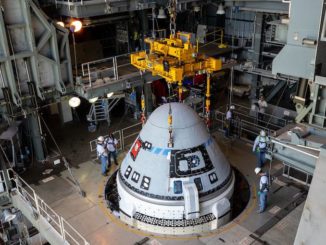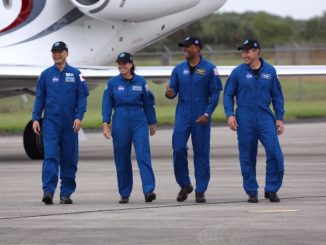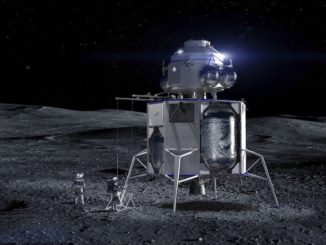
NASA has selected two satellite missions for launch on the same rocket in 2022 to investigate the origins of the solar wind and explore the interaction between magnetic fields around Earth with those from the sun.
The Polarimeter to Unify the Corona and Heliosphere, or PUNCH, mission will include four suitcase-sized microsatellites designed to image the outer solar corona, or the sun’s atmosphere, where the solar wind emerges before traveling throughout the solar system.
“The vacuum of space between the planets is not completely empty — it is actually filled with a tenuous, hypersonic ‘solar wind’ that streams out from the corona and affects spacecraft and planets — including our own,” said Craig DeForest, PUNCH’s principal investigator from the Southwest Research Institute in Boulder, Colorado. “PUNCH will observe the ‘no-man’s land’ between the outer solar corona and the solar wind, giving us our first clear images of the entire system connecting the sun and Earth.”
The PUNCH satellites will help scientists unravel what causes the solar wind’s intensity to fluctuate as it leaves the sun. The mission will also observe coronal mass ejections, massive eruptions of material from the sun that impact satellite operations, and disrupt communication and GPS navigation signals.
“Most of what we know about the space weather delivered by the solar wind comes from direct sampling by spacecraft embedded in it,” said Sarah Gibson, PUNCH’s project scientist and acting director of the High Altitude Observatory in Boulder. “This is like understanding global weather patterns based on detailed measurements from a few individual weather stations on the ground. PUNCH is more like a weather satellite that can image and track a complete storm system as it evolves across an entire region.”
The PUNCH satellites will be built by the Southwest Research Institute in San Antonio. Each PUNCH spacecraft will weigh around 100 pounds (40 kilograms) at launch, and their design is loosely based on NASA’s CYGNSS hurricane research satellites, which were also built by SWRI in San Antonio, DeForest said in response to questions from Spaceflight Now.
Three of the PUNCH satellites will carry wide-field imagers from SWRI designed to detect faint polarized sunlight reflected off of electrons embedded in the solar wind, and the fourth spacecraft will host a narrow-field imager developed at the Naval Research Laboratory to observe the outer corona itself, officials said.

NASA’s funding cap for the PUNCH mission is $165 million, including launch costs.
The PUNCH satellites will launch into a polar sun-synchronous orbit more than 350 miles (570 kilometers) above Earth, where they will separate into a distributed formation around the planet to conduct simultaneous 3D observations of the solar corona and the solar wind.
NASA also announced the selection of the Tandem Reconnection and Cusp Electrodynamics Reconnaissance Satellites, or TRACERS, mission for a grant of up to $115 million.
TRACERS will launch as a secondary payload on the same rocket with PUNCH. The mission will use two spacecraft, built by Millennium Space Systems, to study particles and fields at the Earth’s northern magnetic cusp region near the North Pole. The magnetic cusp is an opening where Earth’s magnetic field lines bend down toward the planet’s surface, providing an opening for solar radiation to reach deep into the atmosphere, particularly during violent geomagnetic storms triggered by outbursts from the sun.
“In the cusp area, with its easy access to our boundary with interplanetary space, TRACERS will study how magnetic fields around Earth interact with those from the sun,” NASA said in a statement. “In a process known as magnetic reconnection, the field lines explosively reconfigure, sending particles out at speeds that can approach the speed of light. Some of these particles will be guided by the Earth’s field into the region where TRACERS can observe them.”
The process of magnetic reconnection is ubiquitous throughout the universe, NASA said. The same physical processes coronal mass ejections and solar flares from the sun.
“TRACERS will be the first space mission to explore this process in the cusp with two spacecraft, providing observations of how processes change over both space and time,” NASA said.
Craig Kletzing from the University of Iowa in Iowa City is principal investigator for the TRACERS mission.
NASA announced the PUNCH and TRACERS missions as winners June 20 in a competition to become the next missions in the agency’s Small Explorers line of space science research satellites.
The space agency selected PUNCH and TRACERS from a list of five candidate missions announced in 2017. Science teams from U.S. research institutions submitted the mission concepts to NASA after the agency issued a call for proposals for a Small Explorer, or SMEX, mission focused on heliophysics.
“We carefully selected these two missions not only because of the high-class science they can do in their own right, but because they will work well together with the other heliophysics spacecraft advancing NASA’s mission to protect astronauts, space technology and life down here on Earth,” said Thomas Zurbuchen, associate administrator for the Science Mission Directorate at NASA Headquarters in Washington. “These missions will do big science, but they’re also special because they come in small packages, which means that we can launch them together and get more research for the price of a single launch.”
NASA said the PUNCH and TRACERS missions are scheduled to launch by August 2022. The space agency will select a dedicated launch vehicle for the two missions at a later date.
Other Small Explorer missions developed by NASA include the NuSTAR X-ray telescope observing black holes and the IRIS mission studying the interface between the visible surface of the sun and the corona. The Imaging X-ray Polarimetry Explorer, or IXPE, mission is next in the SMEX line, set for launch in 2021.
Email the author.
Follow Stephen Clark on Twitter: @StephenClark1.



